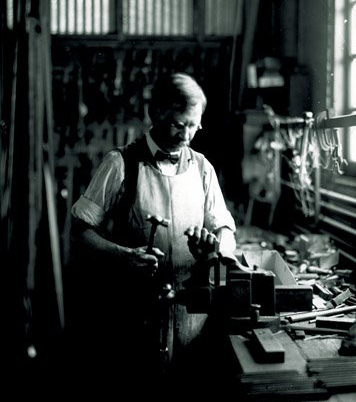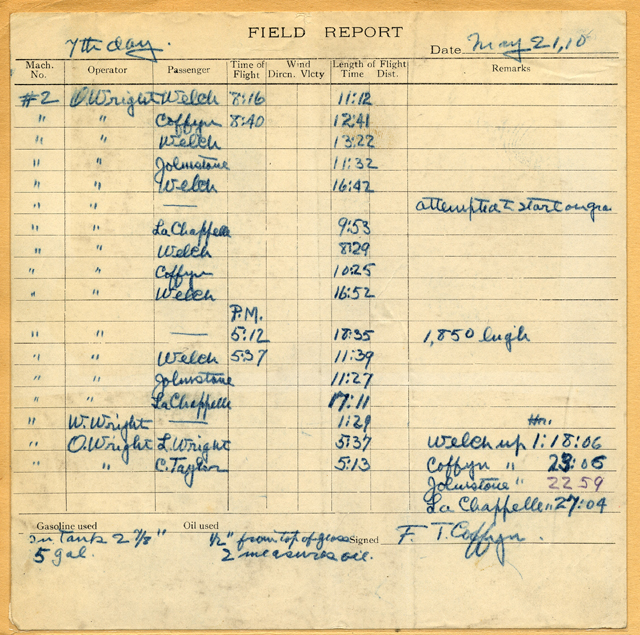Hug an Aircraft Mechanic Today
And remember Charlie Taylor, the Wright Brothers’ mechanic, born on this day in 1868.
/https://tf-cmsv2-smithsonianmag-media.s3.amazonaws.com/filer/62/de/62de07ba-10e9-41d2-8e46-e37ca35ee50e/taylor.jpg)
Modern aircraft are so complex that using the word “mechanics” to describe the people who service them no longer seems to fit; they work surrounded by computers, electronics, and tools that bear no resemblance to the ball-peen hammers of yore. Still, the Aircraft Maintenance Technicians (AMT) Association has established May 24 as a day for national recognition of their profession, and in so doing, pay honor to the man who is considered the very first American AMT.
When the Wright brothers needed help around their bicycle shop, they hired one Charles E. Taylor, a mechanic and machinist. Charlie, as they called him, was the kind of man who might have been described in those days as “good with his hands.” Born in 1868, shortly after the end of the U.S. Civil War, he became a trusted employee around the Wrights’ bike shop in the first years of the 20th century, where he repaired bicycles and even ran the place when the brothers were gone.

Taylor in the Wright Co. factory in 1911. ( Photo Courtesy of Special Collections and Archives, Wright State University)
Although Orville and Wilbur began flying in gliders, their goal was always to fly a powered aircraft that could stay aloft as long as its fuel lasted. To do that, they needed an engine–but not just any engine. When they sought bids from established manufacturers, they stipulated that the engine had to be light but powerful. It also had to run smoothly enough that the vibration didn’t tear their airplanes apart. It was hardly surprising that no one in industry was interested in such a tall order–especially when they were buying just two units. They got no replies.
The Wrights may not have known a lot about engines, but they knew Charlie. Could he produce a 200-cubic-inch engine that delivered eight horsepower, the minimum requirement they’d calculated they would need for their Flyer? According to a remark by Taylor quoted in the Smithsonian monograph series Annals of Flight, “We didn’t make any drawings. One of us would sketch out the part we were talking about on a piece of scrap paper.” Taylor’s capable hands began to turn out the parts: He made the complicated crankshaft entirely by hand from a single “solid block of steel about 32 inches long, six inches wide and one and five-eighths inches thick,” as he recalled in a short documentary made by United Aircraft Corporation on the 50th anniversary of the Wrights’ first flight. First he drilled holes through the steel billet to remove metal, then, when he had the part shaped in rough form, he used a metal cutting lathe to create the circular bearing surfaces on each crank throw. The aluminum crankcase was custom cast by a local Ohio foundry.
It took Taylor just six weeks to finish it, and instead of eight horsepower, it produced about 12. Instead of a heavy, complex carburetor, it had a flat induction chamber on top of the engine with a kind of collar mounted on it that dribbled the fuel into the chamber to vaporize. The basic outlines of that original engine survived evolutionary changes that produced more horsepower and greater reliability, but the engine from the first successful powered flight in 1903 no longer exists. It was damaged, put in storage, then lost.
Charlie lost his life savings during the Great Depression, and after moving to California, fell on hard times. Correspondence between him and Orville Wright (in the collected papers of the brothers) shows an enduring affection and respect between them.
In 2001, the FAA unveiled the Charles E. Taylor Master Mechanic Award for AMTs with 50 years in maintenance who also had at least 30 of those years as licensed airframe and powerplant mechanics. In 2002, California became the first state to celebrate AMT Day and link it to the memory of Taylor. Currently, 52 U.S. states and territories have embraced May 24 as AMT Day, and the U.S. House of Representatives has passed a similar resolution; a Senate measure is said to be underway.
So mark your calendar and try to find some AMTs to thank. It won’t be easy, due to airport security that Charlie and the Wrights could never have imagined. You can always ask a pilot to thank an AMT for you.
